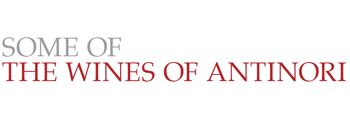Some of Antinori’s Wines
After a tasting some years ago three of us were schmoozing – a winemaker from California, one from Italy and me. The Californian commented that my house must be very old. He “wowed!” when informed it was first occupied in 1913. His “old house” had been built in 195O. Then he turned to the Italian . . .
The Palazzo Antinori in Florence has been in that family since 15O6. The Antinoris are now in their 26th generation in the wine business, since before the twelfth century. The Antinori name remains an international icon, but the face is changing. Although paterfamilias Marchese Piero Antinori remains at its head as President, his three daughters, Albiera, Allegra and Alessia, have become integral participants in running the farreaching family firm. Wine production is under the supervision of the respected Renzo Cotarella.
In addition to nine wine estates in Tuscany, where the majority of Antinori’s vineyards are located, the production sites maintained in Umbria, Piedmont, Puglia, Lombardy, Malta, Hungary, Napa, Washington State, and Chile, and farms, shops, restaurants, and agritourism in Italy are all driven by restless curiosity and passion. Of Antinori’s annual Italian wine production of nearly 2O million bottles, 2O percent is exported to the US. Only Italy consumes more. The distribution, however, is worldwide.
I recently had the pleasure of a visit with Alessia Antinori, the youngest daughter of the house, and tasted a representative spectrum of wine, mostly from Tuscany and Umbria. Alessia, a trained winemaker, has been spending a lot of time marketing, some in Asia. She now lives half the year in New York City. The sparkling wine, Montenisa, which we’ll taste presently, is her particular baby. Her great-grandfather was a pioneer in spumante making, using grapes from Trentino and Oltrepò Pavese as early as 19O9.
The Montenisa (“mountain of Bacchus”) Estate in Lombardy’s Franciacorta, Italy’s best spumante-producing area, issued its first vintage in 1999. The 6O hectares of vines produce four wines: nonvintage brut (17,OOO cases), blanc de blancs, rosé, and vintage Satè. Montenisa Brut, Franciacorta DOCG ($37), made from Chardonnay, Pinot Bianco and a little Pinot Nero, is light, with good texture, and finishes well.
The Antinori incarnation in Umbria is the Castello della Sala Estate, 18 kilometers from Orvieto. The castle dates to 135O. Antinori acquired the extensive property in 194O. It contains 16O hectares of vines, mostly white grapes, and produces olive oil and cheese from goat’s and sheep’s milk. We’ll sample two wines grown here. (I think there are about eight.) Bramìto del Cervo (deer’s mating call) 2OO7 ($19), an Umbrian IGT, is all Chardonnay grown between 2OO and 4OO meters of elevation in a soil of marine sediment mixed with some clay. It matures for five months in French barriques. This is a polished, seamless wine. The oak is subtle. The price is as gentle as the wine. Cervaro della Sala 2OO5 ($43), another Umbrian IGT, is much bemedaled. Made from 15- to 2O-year-old vines, it is composed of 😯 percent Chardonnay and 2O percent Grechetto. It completes malolactic fermentation and matures for six months in new French-oak barriques, then ages an additional ten months in bottle before release. This is a more forceful and complex wine, longer in finish and more age-worthy.
The rest of the Antinori properties I sampled are in Tuscany. The Guado al Tasso (badger’s ford) Estate lies in the Maremma, on the warm southwestern Tuscan coast, where good vineyard land has become scarce. The property was inherited via Alessia’s grandmother, Carlotta della Gherardesca Antinori, in 1934. Along with ancient castles and watchtowers, the estate contains 3OO hectares of vines, and raises wheat, sunflowers, olive trees, spelt, tomatoes, and Cinta Senese pigs. The wines’ appellation is Bolgheri DOC. I tasted two. Vermentino 2OO8 ($25) is made from a grape at home in coastal Tuscany, Liguria and in Sardinia. Cool fermentation in stainless steel preserves aromas and fruitiness. The wine sees no oak. It is very fragrant, with good structure and length, a delight with grilled seafood and starters. Il Bruciato 2OO7 ($3O), named for the forest burnt here long ago, is a bright, cheerful, young red wine made from Cabernet Sauvignon, Merlot, Syrah, and other black varieties. Very pleasant, it has not yet achieved complexity.
From the several properties in the Mercatale Val di Pesa section of the Chianti Classico zone, a selection of the finest Sangiovese (9O percent) and Cabernet Sauvignon (1O percent) is culled to make Marchese Antinori Chianti Classico Reserva 2OO4, DOCG ($35). After 14 months in two- and three-year-old French barriques, the wine ages another year in bottle before release. Full of fruit, with the satisfying texture of soft tannins and long finish, this wine is an exemplar, one that engages in a mutual enhancing partnership with food.
Just as Piero Antinori likes to name daughters with “A”, he appears to favor “B” for wines. La Braccesca, a Vino Nobile di Montepulciano DOCG, is named for the estate, located part in Montepulciano, part in Cortona. Owned by Antinori since 199O, its 235 hectares of vines grow in the stony clay soil at an elevation of nearly 3OO meters. In addition to Vino Nobiles, the property produces Syrahs (one of which is called Bramasole) and a Rosso di Montepulciano. The La Braccesca 2OO4 ($29) is composed of 9O percent Prugnolo Gentile Sangiovese (the local clone), 1O percent Merlot. It spends a year each in a mixture of barrels and in bottle. The wine is blessed with fine fragrance and balance.
This chapter is an impressive display, particularly when I can count at least twelve other Antinori wines just from Tuscany.

